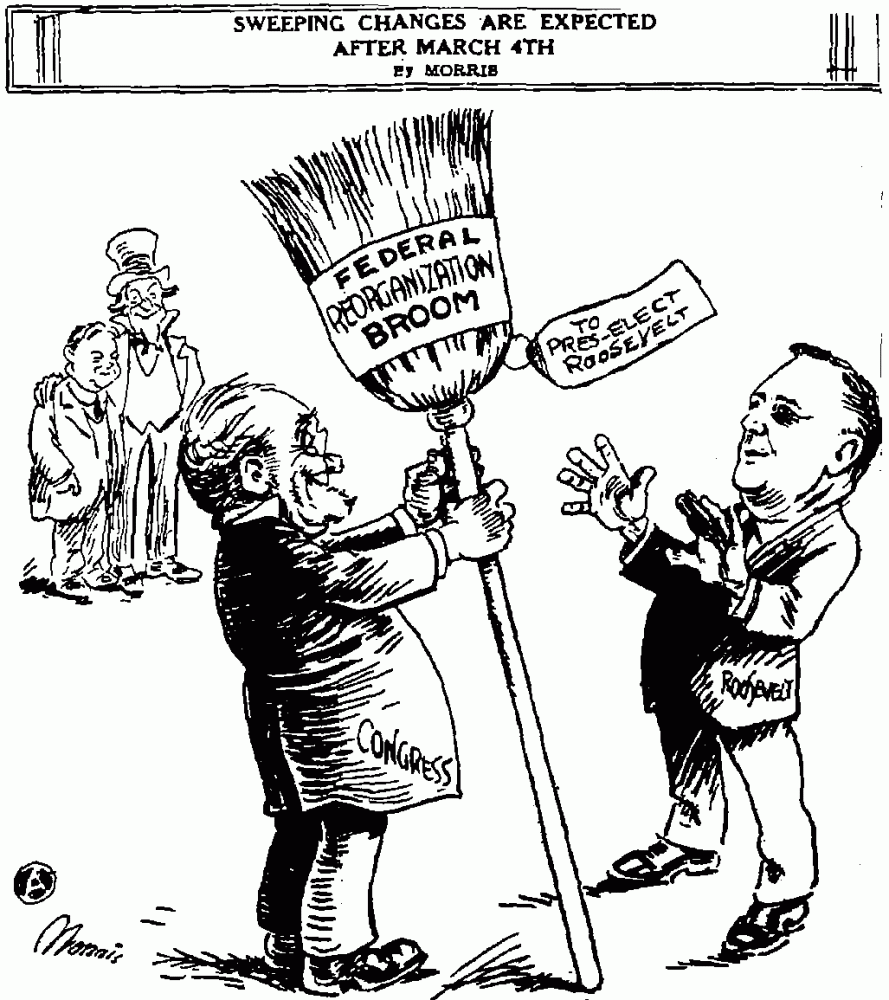“The First Hundred Days” occurred in March, April, May, and June of 1933 when Franklin Roosevelt became president and he began to send bills to congress. Congress passed 15 major laws to fix the crisis. His first major priorities were 1) to fix the banks with programs such as the FDIC and 2) employ the unemployed in programs such as the TVA, the CCC and the establishment of the National Recovery Act.
In the featured headline cartoon shown above, the congress gives Roosevelt the broom representing the power for him to fix the crisis. This “sweeping power” made a big difference because it allowed the President to get much of his New Deal plans passed by Congress very quickly. It gave F.D. R. a type of law making power that most Presidents today do not have due to a divided Congress.
http://apus-b.wikispaces.com/depression-political%20cartoons
March 9– Roosevelt signs the Emergency Banking Relief Act and three days later delivers his first fireside chat.
The act required federal examiners to survey the nation’s banks and issue Treasury Department licenses to those that were financially safe. President Roosevelt talks to the nation directly through radio to let the Americans know what he was trying to do. He told people that their money will be safe if they put it back into the banks. When the banks opened back up after the speech; the bank crisis was over.
March 31– The civilian Conservation Corps (CCC) is created and soon afterward begins hiring young men to work in the forest.
This offered young men 18- 25 years old to work by planting trees, fight forest fires, and building reservoirs. They planted a line of more than 200 million trees from North Texas to North Dakota to prevent another dust bowl from happening. These men lived in camps near where they worked making $30 a month and $25 that goes to their families. This program taught self-respect and taught them to read and write.
May 12– the Agricultural Adjustment Act is signed, and farmers soon begin receiving payments to destroy their crops in an effort to push up prices. The Federal Emergency Relief Administration begins making grants to states to help the unemployed.
Prices for farm goods were low because farmers grew too much food. The government would pay some farmers not to raise certain livestock and certain crops. Some farmers were told not to produce dairy products. Farmers slaughtered and plowed fields just to raise prices. They received more than $1 billion for support payments. Farm surplus fell and food prices were raised. There were 4 major droughts during the 1930s which caused “dust bowl” conditions on mid-west farms and pushed many farmers out of business.
text book 652-659
The cartoon above shows that the New Deal programs were still needed in F.D.R.’s second term but some people thought they were not working and were wasting government money. While the New Deal kept the Great Depression from getting worse, some of its programs were called “unconstitutional” by the Supreme Court and it was World War II in 1939 that finally helped end the Great Depression. The depression ended because the war increased industrial production and trade. More factories opened and more Americans were employed.


